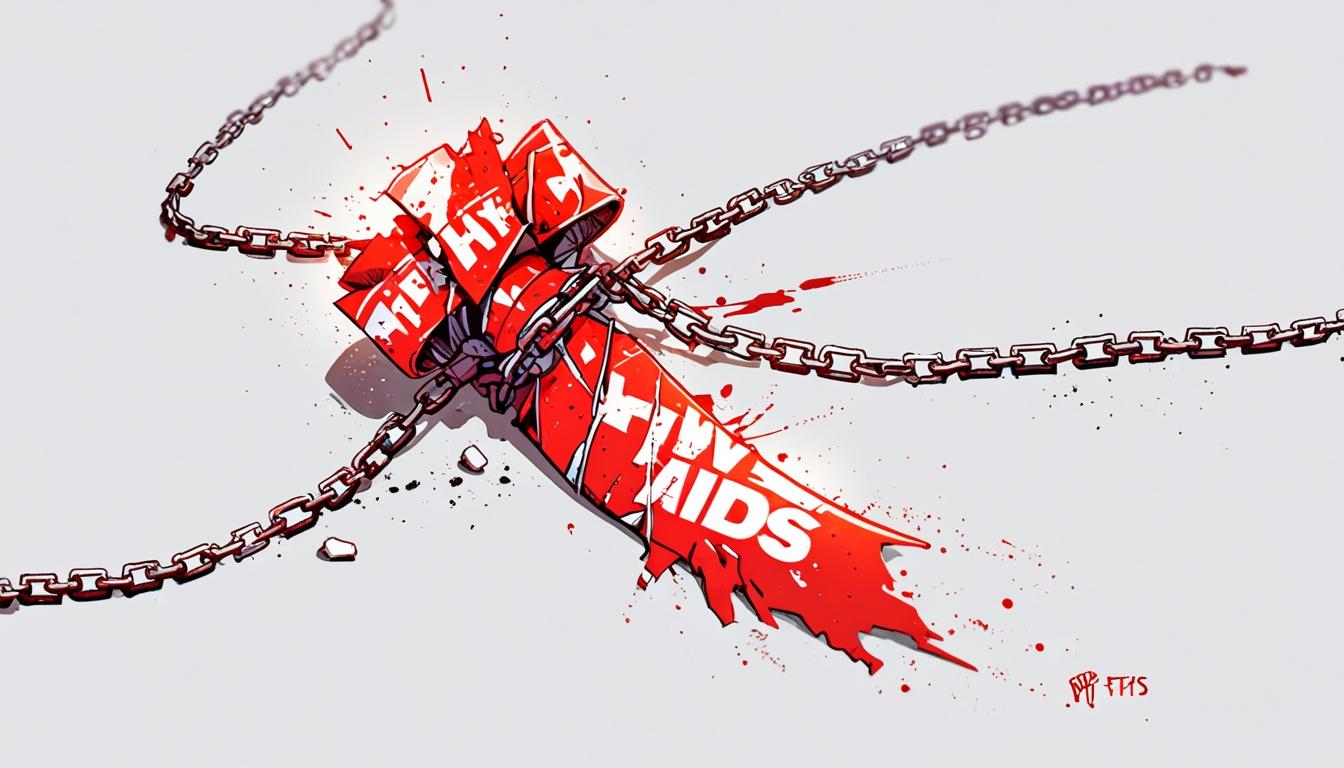The suspension of key international funding for HIV/AIDS programmes, including the US-led Pepfar initiative, threatens millions of lives across Africa and the Global South, risking millions of deaths and new infections unless urgent replenishment and global cooperation occur.
Since the freezing and reduction of international funding for HIV/AIDS programmes, there has been a significant and growing crisis in the global fight against AIDS, particularly in Africa and other parts of the Global South. This crisis follows budget cuts and funding freezes enacted by several major donor countries including the United States, the United Kingdom, France, and Belgium, affecting critical programmes led primarily by the U.S. President’s Emergency Plan for AIDS Relief (Pepfar).
Serge Douomong Yotta, Advocacy Director at Coalition PLUS, an anti-AIDS organisation, has provided a detailed analysis of the implications of these funding reductions. According to estimates from UNAIDS cited by Yotta, the dismantling of Pepfar and similar programmes could lead to 6.3 million AIDS-related deaths by 2029 if current trends continue unabated. This figure starkly illustrates the potential scale of human loss—comparable to or exceeding the combined fatalities of numerous historical wars such as the Vietnam War, the Iran-Iraq War, and even more recent conflicts including the war in Ukraine and the Gaza Strip. Alongside deaths, there are projected to be millions of new infections including around 370,000 babies born with HIV, half of whom may not survive beyond their second birthday without treatment.
Pepfar’s suspended aid has already had concrete effects in countries heavily reliant on US funding: thousands of health workers have been lost in Kenya, Malawi, South Africa, and Mozambique; diagnostic and treatment services for pregnant women and children have been disrupted in Zimbabwe; community outreach programmes have been curtailed or stopped entirely in Angola and Eswatini; and substantial losses are expected within Ukraine’s network of people living with HIV. Reports indicate that without a lifting of aid freezes, 86% of anti-AIDS programmes could see their clients lose access to treatment within one month.
This crisis unfolds amid wider geopolitical shifts where many donor countries have simultaneously increased military spending while cutting health aid. For instance, the UK has slated a 40% aid reduction by 2027 even as it raises its defence budget by 2.6%. Similar trends are seen in France, Belgium, and across NATO states which have achieved their defence spending targets, highlighting a shift in governmental priorities.
Yotta reflects on the historical context and international commitments to fighting AIDS—from the foundation of UNAIDS in 1996, the Global Fund in 2002, to President George W. Bush’s initiation of Pepfar in 2003—and recalls the global mobilisation of activists and public figures supporting HIV/AIDS awareness and treatment. He highlights how political declarations and past progress on equitable access to antiretroviral therapies seem to have been overshadowed by current political and economic priorities.
Looking forward, Yotta identifies several strategies to address the looming crisis:
-
Replenishment of the Global Fund: An important international fundraising event is scheduled for September 2025 in London, with the Global Fund requiring at least US$18 billion to maintain current achievements and save an estimated 23 million lives by 2029. The optimal needed funding could be around US$28.1 billion for fighting HIV, tuberculosis, and malaria.
-
Technology Transfer and Capacity Building: There are calls for advanced countries to facilitate transfer of skills, technology, and production capacity to the Global South. This includes waiving intellectual property rights to enable local production of vaccines, diagnostics, and treatments, which would reduce dependency on the Global North and private sectors.
-
Debt Relief and Improved International Cooperation: Policies like the Lusaka Agenda and stronger advocacy for debt relief in Global South countries are recommended to advance health sovereignty and enhance local capacities supported by civil society involvement.
-
Health Systems and Funding Models: Yotta critiques the approach of treating health as a business, stressing that care should be viewed as a human right. Effective epidemic responses require well-funded, coordinated health systems grounded in science and solidarity.
-
Innovative Financing Mechanisms: There are proposals to revive innovative solidarity financing mechanisms, such as taxes on soda, airline tickets, alcohol, and tobacco in Africa, which could be directed toward health funding.
-
Community and Activist Solidarity: Yotta stresses the importance of unity among diverse activist groups, including those fighting for HIV equity, gender equality, and against discrimination such as homophobia and transphobia. He emphasises that such social justice work is not a distraction but essential to combatting the epidemic comprehensively.
Yotta concludes with a call to urgent and concerted action, urging stakeholders to adapt, mobilise, and form united fronts to maintain gains against HIV/AIDS and prevent dire consequences for millions of people worldwide. The current moment is one of critical decision-making that will significantly influence global health futures.
The Erasing 76 Crimes publication is reporting that the situation represents a significant setback in global public health efforts, demanding renewed attention and international cooperation to prevent millions of unnecessary deaths from HIV/AIDS in the coming years.
Source: Noah Wire Services
- https://www.unaids.org/en/impact-US-funding-cuts/About – This UNAIDS page details the impact of U.S. funding cuts on global HIV response, including the potential for 6.3 million AIDS-related deaths by 2029 if PEPFAR is not re-authorized.
- https://www.theguardian.com/global-development/2025/feb/28/usaid-funding-health-development-hiv-aids-antiretroviral-mothers-lgbt-sex-workers-south-africa – An article from The Guardian discussing how the U.S. shutdown of HIV/AIDS funding could lead to over 500,000 deaths in South Africa over the next decade.
- https://www.politico.eu/article/nearly-3m-hiv-deaths-due-to-foreign-aid-cuts-study-forecasts/ – A study published in The Lancet HIV, reported by Politico, forecasting nearly 3 million HIV-related deaths due to foreign aid cuts by the end of the decade.
- https://www.reuters.com/business/healthcare-pharmaceuticals/aid-funding-disrupts-child-vaccinations-almost-much-pandemic-says-un-2025-04-24/ – Reuters reports on how global aid funding cuts, particularly by the United States, are severely impacting childhood vaccination efforts, nearing the disruption levels seen during the COVID-19 pandemic.
- https://www.frontlineaids.org/news-and-resources/funding-cuts/ – Frontline AIDS discusses the crisis in HIV response due to U.S. foreign aid cuts, highlighting the potential for a tenfold increase in AIDS-related deaths to 6.3 million by 2030.
- https://www.unaids.org/en/resources/presscentre/featurestories/2025/march/20250312_sitrep – UNAIDS provides a weekly update on the impact of U.S. funding cuts on HIV programs, detailing the termination of health worker contracts and the closure of community health services.
- https://news.google.com/rss/articles/CBMingFBVV95cUxQOTZwbFZxOHJndW9WbDVZckxPRk9HQng4d2t1eUdNTWhWS0JCeGRUcHNkdG4yQUVvWjZIUG1aUHBLQ3ZKMThoNkVlcDBwZUpGTGpZYVU5LVNxcVRhMERnaTRHa0IwUDB6cE9Rd0tTMmlZME4tREQ3dlhLOTZ1MWlRN3NaanNtQ0dmM1BrTmVlVElhWFNDODhkRUdMRlV1UQ?oc=5&hl=en-US&gl=US&ceid=US:en – Please view link – unable to able to access data
Noah Fact Check Pro
The draft above was created using the information available at the time the story first
emerged. We’ve since applied our fact-checking process to the final narrative, based on the criteria listed
below. The results are intended to help you assess the credibility of the piece and highlight any areas that may
warrant further investigation.
Freshness check
Score:
8
Notes:
The narrative discusses ongoing funding cuts and their impacts, with references to current geopolitical shifts and upcoming events like the Global Fund replenishment in September 2025. However, specific details about recent changes in donor policies or additional fresh developments are not extensively detailed.
Quotes check
Score:
6
Notes:
Direct quotes are attributed to Serge Douomong Yotta, but no specific online sources are identified as the earliest reference for these quotes. This could suggest original sourcing, though without further verification, it remains uncertain.
Source reliability
Score:
5
Notes:
The narrative originates from an intermediary news aggregator at Google News, referencing Erasing 76 Crimes publication. While it mentions several reputable organisations and initiatives, it does not directly stem from a well-known reputable publication like BBC or Reuters.
Plausability check
Score:
9
Notes:
The claims about funding cuts and their impacts on HIV/AIDS programmes are plausible given recent geopolitical trends and shifts in international priorities. The narrative is supported by references to specific organisations and potential consequences that align with plausible global health challenges.
Overall assessment
Verdict (FAIL, OPEN, PASS): OPEN
Confidence (LOW, MEDIUM, HIGH): MEDIUM
Summary:
The narrative presents a plausible scenario highlighting significant challenges in the global fight against HIV/AIDS due to funding cuts. While the information seems well-grounded in reality, the medium confidence level stems from the reliance on aggregated news without direct quotes from primary sources and the lack of detailed freshness regarding specific recent developments.













